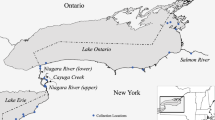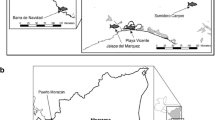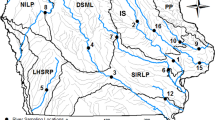Abstract
To examine the suitability of fish scales as a historical archive, of environmental mercury (Hg) contamination, we analyzed a collection of scales taken from striped bass (Morone saxatilis) captured in the St. Lawrence Estuary between 1994 and 1962. The total mass of Hg in individual scales increases linearly with the weight of the scale, suggesting that Hg is well preserved in the scale tissue. Age, length, and sex of specimens captured during the same year did not significantly influence the concentration of Hg in the scales. The average Hg concentrations in scales of specimens captured in 1956 (53.2 ±9.1 ng g−1) and 1962 (58.6±7.7 ng g−1) are nearly twice as high as in scales from 1951 (30.2±3.0 ng g−1). These results follow the trend revealed in sediment cores from the St. Lawrence Estuary. A high level of Hg in scales from 1945 (68.7±18.4 ng g−1) could have been caused by an episode of Hg contamination around 1945 not recorded in the sediment or by a diet-related change in Hg exposure.
Similar content being viewed by others
Literature Cited
Asmund, G. andS. P. Nielsen. 2000. Mercury in dated Greenland marine sediments.Science of the Total Environment 245:61–72.
Cossa, D. 1990. Chemical contaminants in the St. Lawrence Estuary and Saguenay Fjord, p. 239–268.In M. I. El-Sabh and N. Silverberg (eds.), Oceanography of a Large-scale Estuarine System. Springer-Verlag, New York.
Couillard, M. andG. Guay. 1980a. Contamination de l'environment par l'usine de chlore-alcali Alcan, Arvida. Environment Illimité Inc, Bureau d'étude sur les substances toxiques, Environment Québec, Québec, Canada.
Couillard, M. andG. Guay. 1980b. Contamination de l'environnent par l'usine de chlore-alcali C.I.L. Shawinigan. Environment Illimité Inc, Bureau d'étude sur les substances toxiques, Environments Québec, Québec, Canada.
El-Sabh, M. I. andN. Silverberg. 1990. The St. Lawrence Estuary: Introduction, p. 1–9.In M. I. El-Sabh and N. Silverberg (eds.), Oceanography of a Large-scale Estuarine System. Springer-Verlag, New York.
Engstrom, D. R. andE. B. Swain. 1997. Recent declines in atmospheric mercury deposition in the upper Midwest.Environmental Science and Technology 31:960–967.
Flemengs, S., R. W. Furness, and I. M. Davies. 2000. Contemporary patterns and historical rates of increase of mercury contamination in different marine food chains. ICES Annual Science Conference, Bruges; Marine habitats, ICES CM 2000/S:07. Bruges, Belgium.
Frederick, P. C., B. Hylton, J. A. Heath, andM. G. Spalding. 2004. A historical record of mercury contamination in southern Florida (USA) as inferred from avian feather tissue.Environmental Toxicology and Chemistry 23: 1474–1478.
Gobeil, C. andD. Cossa. 1993. Mercury in sediments and sediment pore water in the Laurentian trough.Canadian Journal of Fisheries and Aquatic Sciences 50:1794–1800.
Johannessen, S. C., R. W. Macdonald, andM. K. Eek. 2005. Historical trends in mercury sedimentation and mixing in the strait of Georgia, Canada.Environmental Science and Technology 39:4361–4368.
Johnson, M. G. 1989. Metals in fish scales collected in lake Opeongo, Canada, from 1939 to 1979.Transactions of the American Fisheries Society 118:331–335.
Lake, J. L., S. A. Ryba, J. R. Serbst, andA. D. Libby. 2006. Mercury in fish scales as and assessment method for predicting muscle tissue mercury concentrations in largemouth bass.Archive of Environmental Contamination and Toxicology 50:539–544.
Landers, D. H., C. Gubala, M. Verta, M. Lucotte, K. Johansson, T. Vlasova, andW. L. Lockhart. 1998. Using lake sediment mercury flux ratios to evaluate the regional and continental dimensions of mercury deposition in artic and boreal ecosystems.Atmospheric Environment 32:919–928.
Loring, D. H. andJ. M. Bewers. 1978. Geochemical mass balances for mercury in a Canadian fjord.Chemical Geology 22:309–330.
Louchouarn, P. andM. Lucotte. 1998. A historical reconstruction of organic and inorganic contamination events in the Saguenay fjord/St. Lawrence system from preindustrial times to the present.Science of the Total Environment 213:139–150.
Magnin, É. andG. Beaulieu. 1967. Le bar, Roccus Saxatilis (Walbaum), du fleuve Saint-Laurent.Naturaliste Canadien 94: 539–555.
Mansueti, R. J. 1961. Age, growth, and movements of the striped bass,Roccus saxatilis, taken in size selective fishing gear in Maryland.Chesapeake Science 2:9–36.
Mason, R. P. andG.-R. Sheu. 2002. Role of the ocean in the global mercury cycle.Global Biogeochemical Cycles 16:1093, 1029/2001G-B001440.
Merriman, D. 1941. Studies on the striped bass (Roccus saxatilis) of the Atlantic coast.Fishery Bulletin of the Fish and Wildlife Service 50:1–77.
Nriagu, J. O. andJ. M. Pacyna. 1988. Quantitative assessment of worldwide contamination of air, water and soils by trace metals.Nature 333:134–139.
Outridge, P. M., K. A. Hobson, R. Mcneely, andA. Dyke. 2002. A comparison of modern and preindustrial levels of mercury in the teeth of beluga in the Mackenzie delta, northwest territories, and walrus at Igloolik, Nunavut, Canada.Arctic 55: 123–132.
Outridge, P. M., R. Wagemann, andR. Mcneely. 2000. Teeth as biomonitors of soft tissue mercury concentrations in beluga,Delphinapterus leucas.Environmental Toxicology and Chemistry 19: 1517–1522.
Pirrone, N., I. Allegrini, G. J. Keeler, J. O. Nriagu, R. Rossmann, andJ. A. Robbins. 1998. Historical atmospheric mercury emissions and depositions in North America compared to mercury accumulations in sedimentary records.Atmosphreic Environment 32:929–940.
Pirrone, N., G. J. Keeler, andJ. O. Nriagu. 1996. Regional differences in worldwide emissions of mercury to the atmosphere.Atmospheric Environment 30:2981–2987.
Pruell, R. J., B. K. Taplin, andK. Cicchelli. 2003. Stable isotope ratios in archived striped bass scales suggest changes in trophic structure.Fisheries Management and Ecology 10:329–336.
Quémerais, B. and D. Cossa. 1995. Protocoles d'échantillonnage et d'analyse du mercure dans les eaux naturelles. Environnement Canada—Région du Québec, Conservation de l'environnement Centre Saint-Laurent, Scientific and technical report ST-31, Québec, Canada.
Rasmussen, P. E. 1994. Current methods of estimating atmospheric mercury fluxes in remote area.Environmental Science and Technology 28:2233–2241.
Robitaille, J. A. 2001. Biologie et exploitation de la population disparue de bar rayé (Morone saxatilis) du Saint-Laurent. Société de la faune et des parcs du Québec, Fondation de la faune du Québec, Bureau d'écologie appliquée. Québec, Canada.
Schuster, P. F., D. P. Krabbenhoft, D. L. Naftz, C. Dewayne, M. L. Olson, J. F. Dewild, D. D. Susong, J. R. Green, andM. L. Abbott. 2002. Atmospheric mercury deposition during the last 270 eyars: A glacial ice core record of natural and anthropogenic sources.Environmental Science and Technology 36:2303–2310.
Scott, W. B. andE. J. Crossman. 1974. Poissons d'eau douce du Canada. Service des pêches et des sciences de la mer, Ministere de l'environnement, Ottawa, Canada.
Thompson, D. R., S. Bearhop, J. R. Speakman, andR. W. Furness. 1998. Feathers as a means of monitoring mercury in seabirds: Insights from stable isotope analysis.Environmental Pollution 101:193–200.
Thompson, D. R., R. W. Furness, andP. M. Walsh. 1992. Historical changes in mercury concentrations in the marine ecosystem of the north and north-east Atlantic ocean as indicated by seabird feathers.Journal of Applied Ecology 29:79–84.
Vandal, G. M., W. F. Fitzgerald, C. F. Boutron, andJ.-P. Candelone. 1993. Variations in mercury deposition to Antarctica over the past 34,000 years.Nature 362:621–623.
Vladykov, V. D. andJ. Brousseau. 1957. Croissance du bar d'amérique,Roccus saxatilis, dans le Québec. Département des Pêcheries, Québec, Canada.
Wells, B. K. 1991. Evaluation of fish scale chemistry for determining habitat associations. Ph.D. Dissertation, Department of Ecological Sciences, The University of Old Dominion, Norfolk, Virginia.
Author information
Authors and Affiliations
Corresponding author
Rights and permissions
About this article
Cite this article
Desjardins, C., Gobeil, C. & Sundby, B. Suitability of fish scales as archives of temporal variations in ambient mercury levels in estuaries. Estuaries and Coasts: J ERF 29, 855–859 (2006). https://doi.org/10.1007/BF02786536
Received:
Accepted:
Issue Date:
DOI: https://doi.org/10.1007/BF02786536




